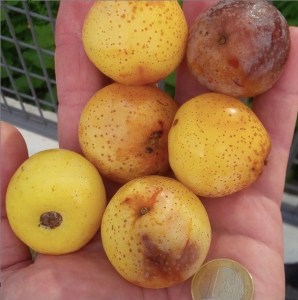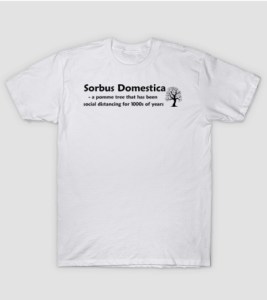Arnould Narazian of Paris, France is a Sorb Enthusiast
Sorbs is the nick name of what is known as Sorbus Domestica. Enthusiast Arnould Narazian in this episode shares his knowledge and passion for this King of all Pommes. There is so much to say about sorbs, like: This “Service Tree’s wood was used for wooden screws used in wine presses and the fruit to help cure ailing cider and wine. A great factoid, but that is just one of many amazing historical and present day uses.
This chat was recorded at Cidrexpo in February 2020 in Caen France.
The main chat begins at 9:20 minutes
Traditional and Cultural Names for Sorbus Domestica
- North of France it is called “Cormé”
- South of France it is referred to as “Sorb”
- Service Tree
- Speierling – German
What inspired Arnould’s affection for Sorbus Domestica?
A dream and a visit to a train station in the north of Paris called Gare d’Achères–Grand-Cormier based to the North west of Paris in the town of Achères
What are the special attributes of Sorbs?
- Sorbus domestica was used for making mechanical devices such as cog wheels for mills. This was very important for milling up corn and grains for food. These mechanisms came about in the Middle Ages of the 11-12th century. And the wood today is still used in the making of musical instruments.
- The wood was also used for the main screw used to press both wine and olives for olive oil. And, early printing presses used Sorb wood too!
Germinating Sorbus Domestica
For the seeds to geminate they must be eaten by a bird or rabbit first. But Arnould has since found some other ways to germinate this King of Pommes.
- Source seeds in October/November – they must be immediately be placed into moist sand.
- Then placed in a refrigerator at 2degree Celsius or 35 degrees Fahrenheit.
- Then the seeds are put outdoors in March
- The odds of the seed germinating is 95%.
Growing Conditions for Sorbs
- Sandy soil
- Sun light
- Not a lot of water
- And the roots can be 6-8 meters down which translate to 26 feet!
What does the Sorb fruit look like?
The fruit of a Sorbus Domestica look like miniature apples and pears and have a range of colors from red, green, yellow and orange. The shape can be round or pear like.
Are there different varieties of Sorbus Domestica?
Arnould says yes, but those varieties are now lost.
Sorbs though large have a special attribute that enables farmers to plant these trees in crop fields
Arnould calls the leaves “Pinnate” referring to the shape and that they are small and thus cast a very light shadow for the surrounding area
The Day of the Cormé – a celebration of Sorb held in November
Buy trees, marmalade, wood products, held in Normandy.
Contact Arnould
- via Instagram: https://www.instagram.com/arnouldnz/?hl=en
Mentions in this Cider Chat
- TeePublic Cider Chat Swag Store – new designs








You must be logged in to post a comment.